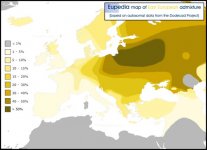mihaitzateo
Regular Member
- Messages
- 943
- Reaction score
- 98
- Points
- 0
- Location
- Bucharest
- Ethnic group
- Romanian
- Y-DNA haplogroup
- proly R1B
So I saw the autosomal DNA maps from this site from here:
http://www.eupedia.com/europe/autosomal_maps_dodecad.shtml

As a very curious thing,where norwegian vikings raided in UK (Scotland) there is more eastern-european admixture.
In England and Wales and Ireland is almost no eastern european admixture.
From what I know,but I might be wrong,anglo saxons came from present day Germany to England and after Y DNA it seems more paternal lines in England are from anglo-saxons.So is clear,old anglo-saxons were not bearing almost at all eastern european admixture.
There is also known that normans moved to England,but I do not know how many from normans were norwegian vikings and I also do not know how many from normans were vikings and how many normans actually mixed the population of England.
So I think is a plausible explanation that eastern european admixture from Scotland was brought by norwegian vikings.
And this is what I was thinking,that it was possible that R1A1 norse vikings,the norwegian vikings had a pretty significant percentage of eastern european admixture,beside their usual north western european admixture from which they got mostly.
As for eastern european admixture in Germany that should be from old prussians,with which old germans it seems mixed and gave today germans.
I was wondering what is the opinion of other people about this.
http://www.eupedia.com/europe/autosomal_maps_dodecad.shtml

As a very curious thing,where norwegian vikings raided in UK (Scotland) there is more eastern-european admixture.
In England and Wales and Ireland is almost no eastern european admixture.
From what I know,but I might be wrong,anglo saxons came from present day Germany to England and after Y DNA it seems more paternal lines in England are from anglo-saxons.So is clear,old anglo-saxons were not bearing almost at all eastern european admixture.
There is also known that normans moved to England,but I do not know how many from normans were norwegian vikings and I also do not know how many from normans were vikings and how many normans actually mixed the population of England.
So I think is a plausible explanation that eastern european admixture from Scotland was brought by norwegian vikings.
And this is what I was thinking,that it was possible that R1A1 norse vikings,the norwegian vikings had a pretty significant percentage of eastern european admixture,beside their usual north western european admixture from which they got mostly.
As for eastern european admixture in Germany that should be from old prussians,with which old germans it seems mixed and gave today germans.
I was wondering what is the opinion of other people about this.







